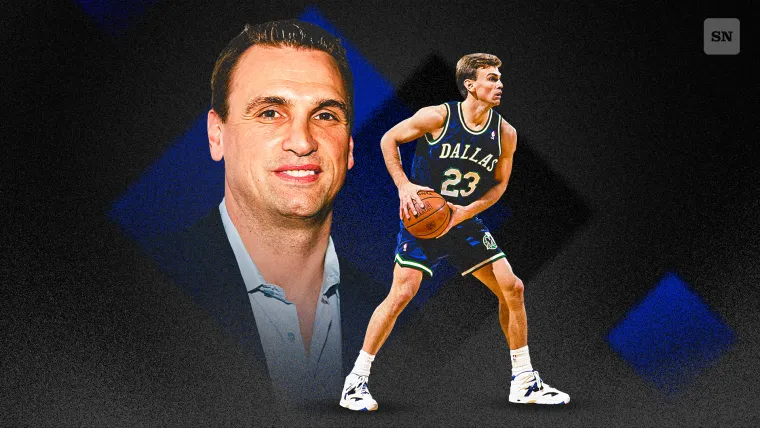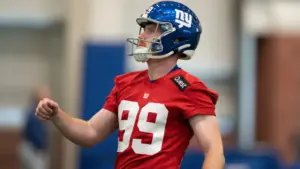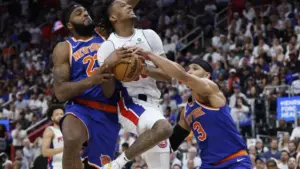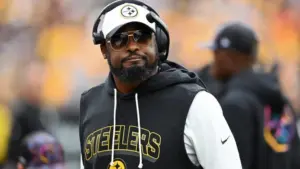Two years ago, NBA commissioner Adam Silver appeared on The Old Man and the Three podcast and lamented the state of the league’s national broadcasts.
“My frustration a bit, I think sometimes the color commentary in our games gets reduced to this team wanted it more, or this team tried harder, as opposed to [explaining] really complex defenses. What’s the offense? Why is this team losing the way they are? Why is this team successful,” Silver noted.
Silver has long wanted the league to follow the NFL’s model, where analysts break down complex schemes into digestible pieces of information for viewers. He doesn’t control broadcast hirings, but he has to be pleased with ESPN’s new shakeup. Tim Legler has been promoted to the network’s lead team for the 2025-26 season, bringing a fresh voice to the league’s premier games.
“I’m going to find something in a game that was really important, that maybe is not going to be in the highlights. That’s what I want to talk about,” Legler told The Sporting News.
MORE: Standings, playoff predictions for 2025-26 season
“I want to talk about something else that took place off the ball that had a lot to do with why the defense was able to guard this or why this guy was open. I am always looking for those gems and nuggets of information so that when I go on the air, it can be different. I want to be different.”
Legler has already started bringing a more analytical approach in taking over Nekias Duncan and Steve Jones’ Coach’s Corner segments. Legler has interviewed coaches around the league and asked them to break down film with him. It’s been a stark contrast to what’s typically shown on ESPN.
Bucks coach Doc Rivers discusses offensive sets used in game with @LegsESPN 👀 pic.twitter.com/PsdCVYJ9vt
— NBA on ESPN (@ESPNNBA) October 14, 2025
Legs has never been afraid of following his own path. When you hear his life story, you begin to understand why.
MORE: Ultimate guide to watching NBA on NBC, ESPN, and Amazon in 2025-26
Tim Legler’s long road to the NBA
There’s a formula most former players use before becoming talking heads in the media. First comes an outstanding college career at a big-name school. Next is a selection in the first round of the draft, followed by a high-profile NBA career, and finally a quick pivot into a featured televised role.
Legler did exactly none of that, taking the hard way instead at every stop.
He was ahead of his time as a pure shooter at La Salle University, hitting a blistering 49.1 percent of his 3’s and averaging 16.7 points per game as a senior. In today’s game, that would have led to a surefire selection in the draft. Back in the 80’s, where 3’s were an afterthought, it made him a fringe prospect.
MORE: Ranking every NBA starter: 1-10 | 11-150
RANKING BY POSITION: PG | SG | SF | PF | C
The 1988 NBA draft had been whittled down from seven rounds to three when Legler submitted his name after his college eligibility was up. He had some teams tell him that he might get picked close to the end of the draft. He watched it alone, with the door locked in the school’s coaches office.
“I didn’t want anybody around in case I was disappointed, because I knew I wasn’t going to be too happy about it.”
Seventy-five names were called. His wasn’t among them. He did get a camp invite with the Cavs as an undrafted free agent but couldn’t stick. From there, he became a hoops vagabond.
First came a championship in Bob Cousy’s 6-foot-5 and under World Basketball League in Youngstown, Ohio, where a globe was printed onto the balls. He was then selected by the Rochester Flyers as the No. 5 pick in the Continental Basketball Association’s draft, which was a precursor to the NBA’s G-League.
“It snowed every day for six months,” Legler recalls of his time in Upstate New York. His Mitsubishi sports car became well-acquainted with AAA’s towing services.
Legler continued grinding for years in the CBA, making little money. He rented apartments in small cities where he didn’t know anyone. At times, he’d play to tiny crowds where the nearest NBA scout was hundreds of miles away.
One night in Fargo, North Dakota, he remembers that it was so cold, he had to put on mittens while he was subbed out of the game. Another night, a local news report carried a story of a man whose eyelids had frozen shut and almost died of hypothermia after his car broke down and he tried to walk a mile to a gas station. Legler watched the story on TV as he prepared to head outside from his hotel to the arena.
“It really made you question, ‘How bad do you want to play basketball?’,” he said.
Legler thought he finally had caught an NBA break during the 1990 preseason. The Timberwolves had paid him to come to camp. He had more money coming in the form of a guaranteed contract if he was still on the roster by the end of the preseason.
Legler outplayed all of the other guards during that training camp. He had a great game in the preseason finale. On the charter plane home, teammate Scott Brooks excitedly told him that he was a lock to make the team.
Legler called his family from his hotel room with a couple hours to go until his contract was set to finalize, telling them that he was feeling great about his chances. Then came a knock on the door. He assumed that it was someone coming to tell him that he’d made the team. Instead, head coach Bill Musselman informed Legler that he’d been cut.
“Everything just kind of went blank,” Legler remembers.
Legs sat at a diner by himself until 4 am, poring over everything he’d done right and how it still wasn’t enough.
“Maybe I should quit,” he thought. He knew that he was good enough, but he didn’t know if the opportunity would ever come for him to show it. That doubt didn’t last long.
“At the end of the day, I loved the game so much. I had so much competitiveness pumping through my veins. It was something I was addicted to, and I didn’t want to let it go.”
MORE: Meet NBA announcers for ESPN, NBC, Amazon and more for ’25-26
Legler grinded the minor leagues again. He moved to France to get his first six-figure payday, playing for a Yugoslovian coach that couldn’t communicate a single word to him. Then it was back to the CBA and NBA 10-days.
Legler was a star in the CBA. He led the league in scoring in 1993, averaging 27.2 points per game and helping the Racers win a championship.
The Mavericks started to take notice. Fifty-two games into the season, their record was a putrid 4-48. Why not give the CBA star a shot? They signed him to a guaranteed contract to finish out their last 30 games.
That little sliver of runway was all he needed. He stuck in the league, finishing his 10-year career with the eighth-best career 3-point percentage in league history.
Legs’ best year was with the Washington Bullets in 1996. He shot a scorching 52.2 percent from 3 and was invited to the 1996 3-point contest. He didn’t know if he would be able to attend due to the upcoming birth of his first child.
Fate was on his side. His son was born just a week before the contest, giving him a chance to participate and a tiny window to prepare. He managed to squeeze in two practice sessions with an equipment manager. They didn’t have five racks to use, so the staffer would sprint to refill one and move it to the next station before he got there.
A few nights later, his aggregate score of 65 out of a possible 90 points had broken the record of his hero, Larry Bird, and given him the win.
“I’m leading the league in 3-point shooting. My first child was born. I win the 3-point shootout. I’m 29 years old. It’s the greatest year of my life,” Legler said.
Everything changed during Game 80 of that regular season. Legs drove to the middle of the floor to shoot a pull-up jumper, a maneuver he’d done tens of thousands of times. Then he crumpled to the floor.
“It felt like somebody stuck a stick of dynamite in my knee.”
Legler’s knee swelled to the size of a watermelon the following day. He had torn three ligaments. Doctors told him to take it easy, that this could threaten his career. His competitiveness drove him to coming back too early. That knee was never right again, even after six additional surgeries.
Legler was traded and waived before the 1999 season. He learned of the deal while on a cruise in the middle of the ocean with season ticket-holders. A kindly septuagenarian fan informed him that she had seen the news on ESPN.
His retirement soon followed, at the age of 33. He was halfway through his final season in Golden State. Coach PJ Carlesimo, who was a large part of why he had signed there, had been fired. His knee still wasn’t right, and he was going through the early stages of a divorce.
“I literally pulled over to the side of the road, I called my agent and said ‘I can’t do this any more. That’s how I retired, on the side of a highway in Oakland, California on the way to practice.”
“I was sitting there going, ‘This is what was waiting for me at the end of all of this.’ I couldn’t believe the cruelty. I could have played at that level for another six, seven, eight years.”
“It was all taken away from me. That was hard for me to cope with.”

ESPN gives Tim Legler a chance
Legs couldn’t stand sitting still after retiring. The anxiety was getting to him. He had been an Academic All-American at La Salle. He thought that he had a chance to get into Wharton’s prestigious MBA program, and so he called up the admissions department. They were delighted to have a former professional athlete in their student body. The only problem? He had to take the GMAT entrance exam, and the timing of his sudden retirement left him with only a week to study.
All Legler needed was a chance. He hurried to the nearest Barnes and Noble and bought a CD-ROM of practice tests. His first attempt delivered a devasting blow. He was nearly 200 points shy of the required acceptance score. A blur of all-night study sessions followed. On the morning of his official exam, his practice score was still a few points below the threshold.
Legler was used to having his back against the wall in pressure moments. He took the test and waited tensely for his results. He had squeaked past Wharton’s stringent cut.
Legler finished that MBA program in good academic standing, but his corporate dreams got put on hold after he got a call out of the blue from ESPN. Writer Ric Bucher asked if he wanted to try his hand at some TV spots. Faced with the option of using his MBA or having a more flexible schedule to spend time with his young kids, it was a no-brainer. He auditioned and was given an opportunity to prove himself in another completely new landscape.
MORE: What to know about ‘Inside the NBA”s switch to ESPN
Legler started from the bottom at ESPN, doing whatever the company asked of him. In what long-time employees refer to as the car wash, he’d appear on a 3pm SportsCenter hit, do multiple segments on radio shows, go on ESPNNews, and close out with NBA Tonight at 2am.
“I was doing about 19 different hits on a given day,” Legler recalled. “They were very, very, very long days. Very demanding days.”
For years, Legler would put on a suit in the morning, go on SportsCenter, fly back to Philadelphia in the afternoon with a gym bag, and run three to four hours of evening practice for his kids’ AAU teams.
In the late hours of the night, he would grind out game film. He regularly compiles 10-12 pages of notes in preparation for the games that he analyzes. Those habits haven’t changed since taking up podcasting, according to Legler’s All-City podcast co-host Adam Mares.
“I always laugh because I’m like hey, you knew we were doing five minutes on this,” Mares told me. “And yet you came prepared with 25 notes.”
Knowing the game is only one part of being a great announcer. As Legler’s predecessor Doris Burke told The Sports Media Podcast back in 2023, “My son just looked at me. ‘Mom, what I think you failed to understand is that when you’re having a good time, we’re coming with you. We’re having a good time with you….people aren’t tuning in to hear how smart you are.”
What makes Legs special is that he knows how to make teaching the game feel entertaining. He’s one of the best storytellers in the industry. He’s rhapsodizes about guarding Michael Jordan, shooting around with Bird, and watching a 15-year-old Kobe Bryant playing pickup games against NBA stars.
“He has a bit of Forrest Gump behind the scenes where he just kind of pops up in all these random places,” Mares said.
Legler is the guy in a bar that you enjoy watching a game with, who also happens to know it as well as anyone else on the planet.
“He gets along with anybody because I think he finds people interesting,” Mares said. “He finds any kind of conversation interesting. He watches basketball the same way, where there’s always five or six things that are interesting about any game.”
Through it all, there is an infectious energy that Legs carries with him during games. He admits that he can be intense, due to his natural adrenaline.
“I get teased a lot about it, but that’s just kind of who I am. It’s definitely helped me achieve my goals in life as a player, and now it’s really helped me in my broadcasting career because I do love the game.”
Legler has always wanted it more. He has tried harder. But there’s a lot more to his story, just as there’s more to the games that he covers. He’s the voice that the league needs to explain the why. After almost a quarter century of saying yes to every opportunity at ESPN, he’s earned his biggest one yet. And Legs is running with it.






